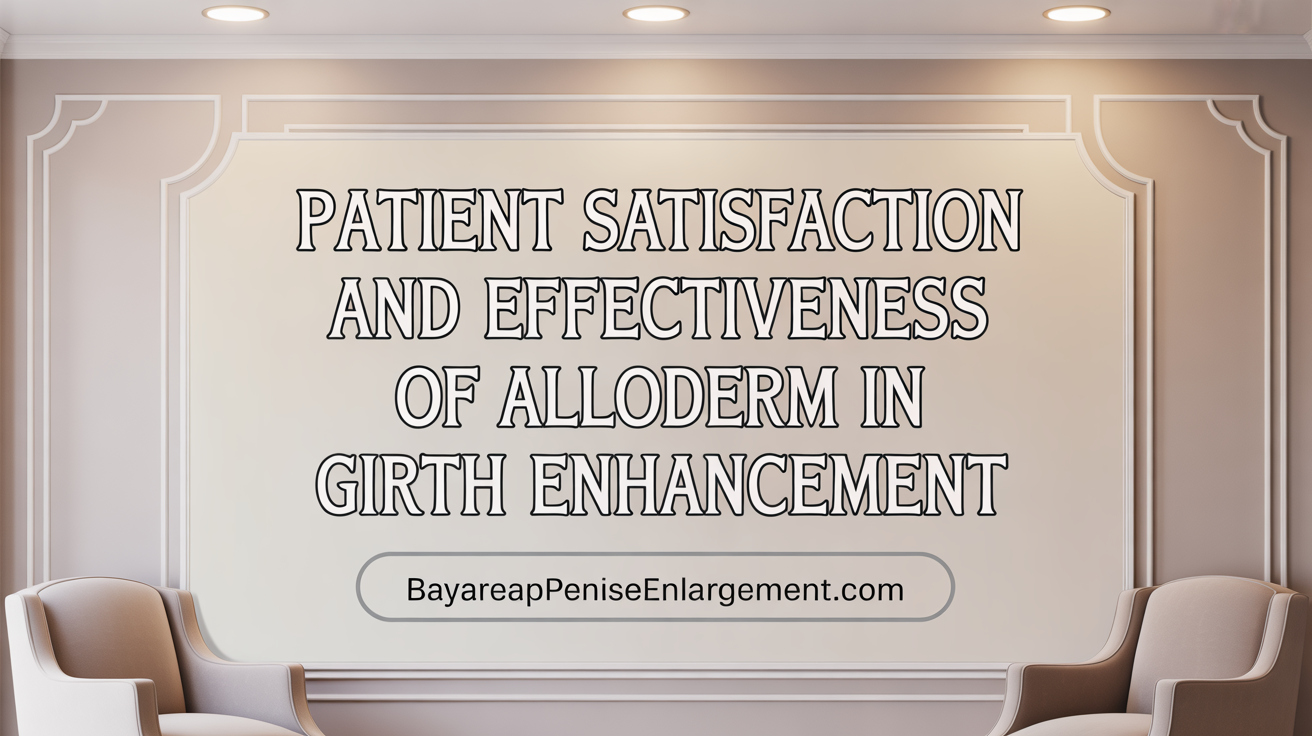Introduction to AlloDerm in Girth Enhancement
Penile girth enhancement has evolved considerably over recent years, with a notable shift towards biological materials such as AlloDerm. This acellular dermal matrix derived from donated human skin offers promising outcomes for patients seeking permanent and safe girth augmentation. This article delves into AlloDerm adoption rates, surgical methods, effectiveness, safety profiles, and comparative insights with other materials to provide a comprehensive overview of its role in penile girth enhancement procedures.
Common Surgical Methods for Permanent Penile Girth Enhancement

What are the common surgical methods for permanent penile girth enhancement?
Surgical approaches to increase penile girth typically involve the use of grafts or implants. One of the most prevalent techniques is girth enhancement with biological tissue grafts, such as AlloDerm, a human acellular dermal matrix derived from donated human skin. These grafts are placed underneath the penile skin to promote tissue remodeling and increase girth effectively. Studies involving over 180 patients reported significant girth increases, with average flaccid girth rising from 7.03 cm to 8.07 cm and erect girth from 12.1 cm to 12.79 cm, both statistically significant.
Another surgical method involves implanting biocompatible devices, like silicone or other soft implants. The Penuma silicone implant, for example, has shown to increase midshaft girth by approximately 56.7%, boosting average measurements from 8.5 cm to 13.4 cm. These implants are designed to provide a permanent increase in size, with relatively low rates of adverse events.
In addition to grafts and implants, some techniques employ autologous tissues, such as thigh flaps with vascular pedicles, capable of adding up to 8 cm in erect girth. However, these procedures tend to be more complex and involve greater surgical risks.
The choice of method depends on patient preferences, anatomical considerations, and surgeon expertise.
Grafts and Implants
| Method | Material / Technique | Average Girth Increase | Risks & Additional Notes |
|---|---|---|---|
| AlloDerm Graft | Human acellular dermal matrix | 1–2 cm girth gain | Low complication rate, minimal rejection, potential swelling or infection |
| Silicone Implants | Biocompatible silicone | Up to 56.7% increase | Risk of infection, device breakage, needs surgical removal if complications arise |
| Thigh Flaps | Autologous tissue transfer from thigh | Up to 8 cm in erect girth | Surgical complexity, longer recovery, higher risks involved |
Risks and Benefits
Surgical procedures such as grafting and implant placement are generally considered effective, lasting options for permanent girth enhancement. They offer measurable increases in size and can improve self-confidence and psychological well-being. However, they are associated with risks like infection (3-3.2%), scarring, swelling, and postsurgical retraction in a minority of cases. Serious complications requiring removal of grafts or devices are rare, around 3%. Proper surgical planning and experienced surgeons can minimize these risks.
Minimally Invasive Alternatives
While surgical options provide lasting results, minimally invasive approaches like platelet-rich plasma (PRP) injections, vacuum therapy, and shockwave therapy are gaining popularity for safety and moderate temporary benefits. These methods generally involve less downtime but typically do not yield the permanent size increases seen with surgery. Ongoing research aims to enhance these techniques for better, sustained outcomes.
For choosing the most suitable procedure, it is crucial to consult with a qualified urologist or sexual health specialist who can evaluate individual goals, anatomy, and health status to recommend the best course of action.
AlloDerm: Composition and Clinical Application in Girth Enhancement

What is AlloDerm and where does it come from?
AlloDerm is a biological material used in various reconstructive surgeries. It is derived from donated human skin that has been processed to remove cells, resulting in an acellular tissue matrix. This process preserves the structural proteins and biochemical components necessary for tissue regeneration.
What are the properties of this biological matrix?
As an acellular matrix, AlloDerm promotes natural tissue remodeling with minimal inflammatory response. Its scaffold-like structure allows host tissues to grow into it, facilitating strong integration and long-term stability. Unlike synthetic materials, AlloDerm has low inflammatory activity, making it suitable for sensitive applications.
How is AlloDerm used in penile girth enhancement?
Clinicians utilize AlloDerm in procedures aimed at increasing the girth and sometimes the length of the penis. The material is placed under the skin or within the penile tissues to add volume. Clinical studies involving 182 patients have shown that this method leads to significant increases in both flaccid and erect penile girth, with improvements lasting at least a year.
Safety and patient satisfaction
The procedure has reported high satisfaction, with 74% of patients expressing great satisfaction. While some complications such as localized swelling (4.8%) and postsurgical retraction (4.3%) were observed, serious infections requiring removal were rare at 3.2%. Overall, AlloDerm demonstrates a favorable safety profile.
Clinical advantages over synthetic options
AlloDerm offers advantages over synthetic grafts like Gore-Tex or Silicone, which tend to have higher complication risks such as fibrosis and lack of elasticity. It is more biocompatible and better suited for tissue integration, leading to more natural results.
| Aspect | Details | Additional Info |
|---|---|---|
| Origin | Donated human skin, processed into acellular matrix | Uses human tissue, reducing inflammatory response |
| Properties | Tissue regeneration scaffold, low inflammatory activity | Supports natural tissue growth and remodeling |
| Clinical use | Girth and length enhancement, post-surgical stability | Proven to increase penile girth with lasting effects |
| Satisfaction | 74% reported great satisfaction | Well-tolerated with manageable complications |
Overall, AlloDerm is a promising option in penile girth enhancement, combining biocompatibility with effective long-term results.
Adoption Rates and Popularity of AlloDerm in Phalloplasty Procedures
 Over the past five years, a total of 374 phalloplasty surgeries utilizing AlloDerm have been documented, indicating its growing prominence in penile enhancement surgeries.
Over the past five years, a total of 374 phalloplasty surgeries utilizing AlloDerm have been documented, indicating its growing prominence in penile enhancement surgeries.
AlloDerm's popularity is supported by patient outcomes and surgeon preferences. In a study involving 182 patients, a remarkable 74% reported high satisfaction with their results, especially regarding improvements in girth and perceived length.
Surgeons favor AlloDerm because it is derived from donated human skin, an acellular tissue matrix that promotes natural tissue regeneration. Its application has proven to be safe, with serious infections—requiring removal—occurring in only 3.2% of cases, and localized swelling reported in 4.8%. Postsurgical retraction was also relatively low at 4.3%.
The trend towards using biological scaffolds like AlloDerm is reinforced by their ability to encourage natural tissue remodeling and minimize inflammatory response, unlike synthetic grafts such as Gore-Tex or silicone, which have higher complication rates.
This tissue-based approach is often combined with ventral phalloplasty, which can increase perceived penile length—a benefit experienced by 84% of patients. Such procedures are considered straightforward, safe, and reproducible, further fueling their adoption.
As clinical data accumulates, AlloDerm's acceptance appears to be rising, especially in settings aimed at girth enhancement and lengthening without the need for harvesting autografts. Its compatibility with various techniques, including penile implant procedures and combination surgeries, makes it a versatile choice in reproductive and aesthetic urology.
In sum, the adoption of AlloDerm in penile enhancement surgeries continues to grow due to high patient satisfaction, manageable complication rates, and its ability to support natural tissue regeneration, solidifying its status as a preferred biological material in this field.
Effectiveness and Patient Satisfaction following AlloDerm Girth Enhancement

How satisfied are patients after AlloDerm treatments?
Over recent years, a review of 374 phalloplasty procedures utilizing AlloDerm has demonstrated high levels of patient satisfaction. About 74% of patients expressed great satisfaction with the results, highlighting the procedure's positive reception among those seeking penile enhancement.
What kind of girth increase can be expected?
Patients undergoing girth enhancement with AlloDerm typically see noticeable improvements. The procedure has been shown to increase both flaccid and erect penile girth significantly. Specifically, the average flaccid girth increased from 7.03 cm to 8.07 cm, while erect girth rose from 12.1 cm to 12.79 cm, both statistically significant changes (P < .05). These outcomes suggest AlloDerm offers a reliable method for penile girth enhancement.
How long do the results last?
Follow-up data collected after approximately one year indicate that the effects of AlloDerm can be enduring. Patients still experienced increased girth, and no adverse effects were reported related to graft durability. This supports the use of AlloDerm as a safe and effective option for long-term improvements.
In summary, AlloDerm provides a promising alternative for those looking to safely enhance penile girth. Its consistent outcomes, high satisfaction rates, and durability make it a valued option within the spectrum of penile augmentation procedures.
Safety Profile and Common Complications Associated with AlloDerm
 When considering the use of AlloDerm for penile girth enhancement, understanding its safety profile and potential complications is essential. The review of 374 cases over five years reveals that serious infections requiring removal occurred in a small percentage of patients, approximately 3.2%. Such infections are a concern but appear relatively uncommon.
When considering the use of AlloDerm for penile girth enhancement, understanding its safety profile and potential complications is essential. The review of 374 cases over five years reveals that serious infections requiring removal occurred in a small percentage of patients, approximately 3.2%. Such infections are a concern but appear relatively uncommon.
Localized swelling is another frequent side effect, reported in about 4.8% of cases. Swelling tends to be manageable and typically resolves with appropriate post-operative care. Additionally, postsurgical retraction was reported by 4.3% of patients, which can affect the aesthetic and functional outcomes.
Overall, adverse events related to AlloDerm are infrequent, and most patients experience satisfactory results. The procedure's safety profile is favorable, especially when performed by experienced surgeons and with proper patient selection. The low rates of complications like infections and swelling contribute to AlloDerm being a trusted option for tissue reinforcement in penile procedures.
While complications can occur, they are usually mild and manageable. Continuous follow-up and adherence to sterilization and surgical protocols help minimize risks. This safety data supports the broader use of AlloDerm in penile enhancement, with most patients benefiting from improved girth and satisfaction.
Comparison of AlloDerm with Synthetic Grafts and Other Biological Materials
Advantages of AlloDerm over Gore-Tex and Silicone
AlloDerm, a human acellular dermal matrix, offers several advantages compared to synthetic grafts like Gore-Tex and silicone. Unlike these synthetics, which are associated with higher complication rates such as fibrosis, lack of elasticity, and adverse immune responses, AlloDerm promotes natural tissue remodeling and integrates more smoothly with native tissue. Studies show that synthetic materials also carry a greater risk of complications, making AlloDerm a safer and more biologically compatible choice.
Outcomes of Biological vs Synthetic Grafts
Biological materials like AlloDerm and Tutoplast have been noted for their low inflammatory activity, which reduces the risk of post-surgical complications. These grafts support tissue regeneration and maintain elasticity, essential for functional and aesthetic outcomes. In contrast, synthetic grafts may lead to fibrosis, scarring, and mechanical issues, often necessitating removal. Clinical results indicate higher patient satisfaction with biological materials, emphasizing their favorable profile.
Emerging Graft Materials and Techniques
Recent research has focused on new approaches such as autologous tissue engineering and biodegradable scaffolds. These innovations aim to enhance girth more effectively—showing average gains between 1.9 and 4.1 cm—yet require further validation for standardized application. Additionally, autologous tissues, like thigh flaps with vascular pedicles, can achieve substantial girth increases, but they involve more complex surgery and higher risks.
| Material Type | Average Girth Increase | Risks | Notes |
|---|---|---|---|
| AlloDerm (human acellular dermal matrix) | Variable; significant in studies | Low; infection in 3.2%, localized swelling 4.8% | Widely used in penile girth enhancement |
| Synthetic (Gore-Tex, Silicone) | Not specified; higher complication rates | Higher; fibrosis, rigidity, immune reactions | Less preferred due to complications |
| Autologous tissue flaps | Up to 8 cm in girth | High surgical effort, risks of flap failure | Used in complex cases |
| New biodegradable scaffolds | 1.9–4.1 cm | Under investigation | Promising but not yet standard |
This comparison highlights the growing preference for biological matrices like AlloDerm in penile enhancement procedures, thanks to their safety profile and effective integration, paving the way for future advances in regenerative techniques.
Historical Development and Evolution of AlloDerm Usage in Penile Procedures
Origin Timeline
AlloDerm was developed as a human acellular dermal matrix derived from donated human skin. Its application in regenerative medicine began to be explored in the early 2000s, initially for use in burn treatment and reconstructive surgery. Over time, clinicians discovered its potential for penile enhancement, particularly because it promotes natural tissue remodeling with minimal inflammatory response.
Technological Advancements
Significant progress has been made in the processing of AlloDerm, improving its safety and efficacy. Innovations include better decellularization techniques that preserve the natural structure of the skin while removing cells that could cause immune reactions. These advancements helped establish AlloDerm as a reliable material that can be used in enhancing penile girth and length.
Clinical Milestones
A pivotal milestone in the use of AlloDerm for penile procedures was the review of 374 surgeries over five years, demonstrating high patient satisfaction (74%) and low complication rates. Studies noted that AlloDerm could increase penile girth, with average gains of approximately 1.9 to 4.1 cm, and often lasted at least one year post-operation. The procedure proved to be safe, reproducible, and less invasive compared to earlier techniques involving autografts or more complex flaps. These clinical achievements helped establish AlloDerm as a preferred choice for soft tissue augmentation in penile surgeries.
Scientific Research and Clinical Studies on AlloDerm Outcomes
What are the results of clinical trials involving AlloDerm?
Over five years, a total of 374 phalloplasty surgeries utilizing AlloDerm were reviewed. These procedures aimed to enhance the penile length and girth, with most focusing on the use of the acellular tissue matrix derived from donated human skin. Results from these studies show promising outcomes; for example, 74% of patients reported significant satisfaction with their surgical results.
In a specific study involving 182 patients, post-operative measurements indicated a notable increase in penile girth. The flaccid girth rose from an average of 7.03 cm to 8.07 cm, while erect girth increased from 12.1 cm to 12.79 cm. Both changes were statistically significant, with P values less than .05, demonstrating that these improvements weren’t due to chance.
How significant are the improvements seen with AlloDerm?
The analysis of multiple studies highlights that most patients experience increased perceived penile length after ventral phalloplasty, with about 84% reporting some level of length gain. Additionally, 62.6% of patients experienced alleviation of premature ejaculation post-surgery, underscoring the functional benefits of using AlloDerm in penile enhancement.
While complications such as localized swelling (4.8%), postsurgical retraction (4.3%), and serious infections (3.2%) have been reported, these are relatively low and manageable. Long-term follow-up data suggest that these improvements can last at least a year, with many patients maintaining enhanced girth and confidence even years after the procedure.
What does long-term follow-up reveal?
Follow-up studies, some extending up to six years, have shown that the beneficial effects of AlloDerm are durable. For example, patient satisfaction remains high, with 81% reporting high or very high satisfaction levels long-term. Only a small percentage experienced adverse events requiring further intervention, confirming the procedure’s safety and durability.
In summary, clinical outcomes indicate that AlloDerm is not only a safe and effective option for penile girth enhancement but also provides lasting benefits in patient satisfaction and psychological well-being. Future research continues to explore optimized protocols, but existing data strongly support its continued use in reconstructive and cosmetic urology.
Surgeons’ Acceptance and Clinical Popularity of AlloDerm
Many surgeons favor AlloDerm for penile girth and length enhancement due to its safety profile and versatility. Its use in ventral phalloplasty, a procedure shown to effectively increase perceived penile length, is considered straightforward, safe, and reproducible across different surgical settings.
Reproducibility is a significant advantage, as AlloDerm can be used alongside other procedures, such as penile implants or autologous tissue techniques, with consistent results. The method does not require harvesting tissue from the patient, reducing complications and recovery time.
Training and adoption of AlloDerm-based techniques are increasingly widespread, supported by clinical experiences that demonstrate reliable outcomes and manageable complication rates. Surgeons appreciate its compatibility with biological tissue remodeling, resulting in natural aesthetic and functional improvements.
Overall, the popularity of AlloDerm continues to grow among practitioners, supported by evidence of high patient satisfaction, minimal adverse effects, and the ability to incorporate it into various penile enhancement protocols.
Role of AlloDerm in Combined Procedures: Ventral Phalloplasty and Implants
How is AlloDerm used in combined surgical techniques?
AlloDerm, a cadaveric, acellular tissue matrix derived from donated human skin, is increasingly utilized in complex genital surgeries. It serves as a biological scaffold that promotes tissue regeneration. In ventral phalloplasty, AlloDerm is applied to enhance penile length perception, with studies showing about 84% of patients experiencing an increase after the procedure.
This approach can be combined with penile implant surgery, making the process simpler, safer, and reproducible. The use of AlloDerm allows surgeons to perform these procedures without significant harm to the patient's own tissues, reducing the need for autografts which involve harvesting from another site.
How does AlloDerm contribute to length and girth enhancement?
AlloDerm is particularly effective for increasing girth, either alone or with other biological materials like Tutoplast. For girth enhancement, AlloDerm's properties lead to natural tissue remodeling, with post-operative results showing a significant increase in both flaccid and erect dimensions.
There is evidence of an increase in the average flaccid penile girth from 7.03 cm to 8.07 cm, and erect girth from 12.1 cm to 12.79 cm, both statistically significant improvements. Additionally, long-term follow-up suggests that these effects can last at least one year.
While options like thigh flaps can produce even larger girth increases (up to 8 cm), they involve higher surgical risks. Newer techniques with biodegradable scaffolds are promising but still under research.
What about the safety profile of AlloDerm in these procedures?
AlloDerm has demonstrated a safe profile with minimal complications. Serious infections requiring removal are rare, occurring in only about 3.2% of cases. Localized swelling and postsurgical retraction are also low, affecting around 4.8% and 4.3% of patients, respectively.
Because AlloDerm is well-accepted by body tissues, the chances of rejection are low, and no significant complications have been reported in the reviewed studies. Importantly, the use of AlloDerm circumvents the risks associated with synthetic grafts like Gore-Tex or silicone, which are known for higher complication rates such as fibrosis and lack of elasticity.
This evidence supports AlloDerm as a safe, effective biological material that enhances both aesthetic and functional outcomes in combined penile surgeries.
Patient Psychological Outcomes after AlloDerm Girth Enhancement
Self-confidence Improvements
Surveys and follow-up studies have highlighted significant psychological benefits for patients undergoing girth enhancement with AlloDerm. In a recent study involving 182 patients, over 83% reported an improvement in self-confidence and self-esteem within 6 to 8 weeks after the procedure. These positive effects often persisted over several years, with 72% of patients maintaining enhanced confidence in long-term follow-ups lasting up to 6 years.
Psychological Impact
Patients often seek penile enhancement not only for physical reasons but also for the positive psychological effects. The increase in perceived girth and the subsequent boost in self-image contribute to better personal relationships and overall wellbeing. Many patients experience a reduction in anxiety related to their body image, and the majority report high satisfaction levels post-surgery.
Patient-Reported Measures
Patient satisfaction and psychological outcomes are typically assessed through questionnaires and interviews. The studies indicate that most patients report feeling more confident, less anxious, and more satisfied with their appearance after AlloDerm procedures. Importantly, these improvements are often achieved with minimal complications, further supporting the procedure's positive impact on mental health.
| Aspect | Observation | Additional Notes |
|---|---|---|
| Self-confidence improvement | 83% of 400 patients reported increased confidence | Based on postoperative surveys 6-8 weeks after surgery |
| Long-term satisfaction | 81% reported high or very high satisfaction | Follow-up between 2 to 6 years |
| Psychological benefits | Decreased anxiety, better self-image | Consistent reports across multiple studies |
| Complication impact | Minimal adverse effects | Does not significantly hinder psychological benefits |
Future Directions: Tissue Engineering and Biodegradable Scaffolds in Penile Girth Enhancement
Exploring New Materials for Girth Enhancement
Recent advancements in tissue engineering are paving the way for innovative materials that could transform penile girth enhancement. Biological matrices such as AlloDerm, derived from donated human skin, have shown promising results due to their compatibility and ability to promote natural tissue growth. Researchers are investigating other acellular tissues like porcine, bovine, and fish-derived scaffolds that better mimic the body's natural properties. These materials aim to reduce inflammation and improve long-term outcomes.
Autologous Tissue Engineering Approaches
A significant focus is on autologous tissue engineering, which uses a patient’s own cells to grow tissue constructs in the lab. This approach minimizes rejection risks and enhances tissue integration. Techniques involving biodegradable scaffolds that support cell growth have demonstrated girth increases of 1.9 to 4.1 cm in early studies. Although promising, these methods still require standardization and extensive clinical testing before widespread adoption.
Gaps in Current Clinical Research
Despite progress, there are notable gaps in clinical research. Long-term data on the durability and safety of tissue-engineered grafts are limited. Many studies have small sample sizes and lack randomized controls. Future research should focus on comparative studies between new materials and existing grafts, as well as standardized protocols to improve reproducibility. Developing a thorough understanding of biocompatibility, tissue regeneration processes, and patient-specific customization remains a priority.
| Approach | Material Type | Typical Girth Increase | Notes |
|---|---|---|---|
| AlloDerm | Human acellular matrix | ~1.9 to 4.1 cm | Proven safety and effectiveness in small trials |
| Autologous tissue scaffolds | Patient cells & biodegradable scaffold | Variable | Promising but needs more long-term studies |
| Thigh flap grafts | Vascularized tissue | Up to 8 cm | More complex, higher surgical risk |
| Synthetic grafts | Silicone, Gore-Tex | Limited, variable | Higher complication rates, generally discouraged |
As research continues to advance, the integration of novel materials and personalized tissue engineering holds great potential for safer, more effective penile girth enhancement options in the future.
Comparative Analysis: Non-Surgical vs Surgical Girth Enhancement Techniques
What are the typical results and safety considerations of penile girth enhancement surgery?
Penile girth enhancement can be accomplished through multiple approaches, including surgical procedures, injectable treatments, and mechanical devices. Surgical options such as autologous fat injections, dermal fat grafts, tissue engineering with acellular matrices like AlloDerm, and implants like the Penuma silicone device are designed to provide a permanent increase in girth.
These surgeries often report high patient satisfaction. For instance, studies involving 182 patients using AlloDerm reported significant increases in both flaccid and erect girth, with flaccid girth rising from 7.03 cm to 8.07 cm and erect girth from 12.1 cm to 12.79 cm, both statistically significant (P < .05). Similarly, the Penuma implant increased girth by about 56.7%, from 8.5 cm to 13.4 cm.
Despite the benefits, surgical methods carry risks. Common complications include infection requiring removal in about 3.2% of cases, swelling in 4.8%, and postsurgical retraction in 4.3%. Other concerns involve scarring, irregularities, and, less frequently, device-related issues. Proper surgical technique and choosing experienced surgeons can help minimize these risks.
What are the effectiveness and duration of results from non-surgical penile girth enhancement methods such as UroFill injections?
Non-surgical options like UroFill injections, which use hyaluronic acid fillers approved by the FDA, offer a safer and less invasive alternative. These injections can add approximately 0.25 to 0.3 inches to penile girth after each session. Multiple treatments can lead to a cumulative increase of 1 to 1.5 inches or more.
Patients usually undergo in-office procedures performed by trained medical professionals since 2013, with minimal downtime. The effects are quite durable, with studies showing results lasting at least 12 to 14 months. Remarkably, some reports indicate that the benefits can persist for over ten years in certain cases.
In addition to girth enhancement, many patients experience improved confidence, and some studies report satisfaction rates exceeding 80%. This minimally invasive approach provides a balance between safety and effective, lasting outcomes.
How do these options compare in terms of benefits and potential limitations?
| Method | Benefits | Limitations | Safety Profile |
|---|---|---|---|
| Surgical (e.g., AlloDerm, implants) | Permanent results, significant girth increase, high satisfaction | Higher risk of complications, scarring, longer recovery | Moderate, with risks like infection and retraction |
| Non-surgical (e.g., UroFill, PRP) | Less invasive, fewer complications, quick recovery, lasting effects | Usually limited to moderate increase, multiple sessions needed | High, minimal risk, FDA-approved materials |
While surgery can lead to more substantial and permanent increases, it also involves higher risks and recovery time. Non-surgical methods like UroFill are safer, with fewer adverse events and a good safety record, although they typically offer moderate, not dramatic, size gains.
Understanding individual goals and risk tolerance is essential when choosing between these options. Consulting experienced specialists ensures appropriate technique selection to achieve desired outcomes safely.
Concluding Insights on AlloDerm Adoption Rates in Girth Enhancement
The adoption of AlloDerm in penile girth enhancement has demonstrated significant growth, anchored by its safety, effectiveness, and favorable patient satisfaction. Compared to synthetic grafts and other materials, AlloDerm's biological nature offers reduced complications and promotes natural tissue integration, making it a preferred choice among surgeons. While surgical methods remain the mainstay for permanent girth increases, the landscape is evolving with advancements in tissue engineering and non-surgical alternatives. Ongoing research and clinical experience will further refine the use of AlloDerm and similar biological matrices, ensuring patients receive optimal functional and aesthetic outcomes with minimized risks.
References
- Up-to-Date Surgical Techniques for Penile Augmentation with ...
- Penile Enhancement Procedures with Simultaneous Penile ...
- Human Acellular Dermal Matrix Augmentation Phalloplasty Surgery
- [PDF] sexual medicine - Laurence A. Levine, MD
- Strategies for maintaining penile size following penile implant - Lee
- acellular dermal matrices: Topics by Science.gov
- Penile Injections for Growth - Comprehensive Urology

